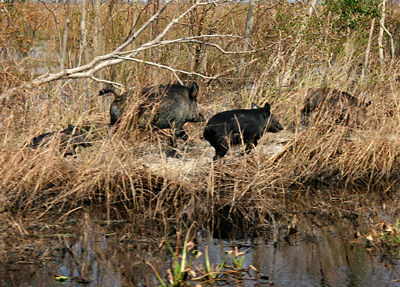Feral hogs and European wild hogs are omnivorous animals. This means feral and wild hogs eat both plant and animal matter. In fact, feral hogs are very opportunistic and much of their diet is based on the seasonal availability of foods. As such, what feral hogs eat depends largely on what they encounter and the season of the year. The food habits of feral hogs can best be described by calling these introduced animals opportunistic omnimovores. They eat what they can find.
Although the diet of a feral hog seems unlimited, the season or time of year will determine the bulk of their food consumption. Spring diets include grasses, forbs, roots, and even tubers. Wild hogs will also use browse, bulbs, and mushrooms. Summer and fall diets consist primarily of soft (fruits such as grapes) and hard (acorns) mast , including grapes, plums, prickly pears, mesquite, acorns and persimmons. Animal matter includes invertebrates (insects, snails, earthworms, etc.), reptiles, amphibians, and carrion (dead animals), as well as eggs, live mammals, and birds if given the opportunity.

The feral hog has an acute sense of smell enabling it to be an efficient predator when given the opportunity. Various domestic agricultural crops are also consumed where present. Peanuts, corn, milo (sorghum), oats, wheat, and soybeans are among feral hog favorites. Feral hogs are especially fond of watermelon, potatoes, and cantaloupe.
Although feral hogs are able to surive well on the limited foods found in various habitats, nutrition is generally the poorest in the winter and best during the spring and fall. Because feral hog foods are most limited during the winter, this is your best opportunity for feral hog trapping and hog hunting. Feral hogs feed primarily at night and during twilight hours, but will also feed during daylight in cold or wet weather.